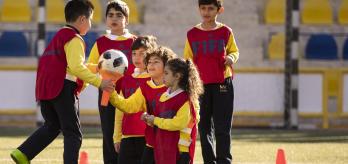In the second part of our General Principles portion of FIFA’s Grassroots Coaching Essentials series, Dr. Jené Baclawski presents another three core principles that will help coaches to make their practice sessions inclusive, game-based and actively engaging for players between the ages of 6 and 15. Here is a full list of Dr. Jené's six principles which have been discussed throughout this two-part series:
- Principle 1: Making practice fun
- Principle 2: Making practice safe
- Principle 3: Making practice effective
- Principle 4: Making practice inclusive
- Principle 5: Applying game-based learning
- Principle 6: Keeping players active
Below, you will find a 10-minute video where Dr. Jené explains principles 4-6 in detail, accompanied by a written summary and diagrams that break down the three sample activities. The first part of our General Principles video, which covers principles 1-3, can be found here.
Principle 4: Making practice inclusive
Making practice inclusive is all about creating a playing environment where each player feels welcome, respecting differences in their gender, race and ability. Dr. Jené highlights how and why coaches can and should make training inclusive for children of all ages:
- Everyone has a role to play: Emphasise from the beginning that every player has a role to play. This ensures that nobody is left out or feels excluded.
- Keep it balanced: Coaches should always be mindful of differences in physical ability or skill levels when designing activities.
- Modify for different ages: For example, girls and boys in the 12-14 age group might have to be separated for certain activities to guarantee safe, comfortable play.
Principle 5: Applying game-based learning
Coaches should always look to apply game-based learning into their practice sessions. This helps players to learn the beautiful game naturally without overloading them with too much information. Here is why implementing a game-based learning approach is key to a successful playing environment:
- The game is the best teacher: Players learn best when they’re immersed in the actual game, making decisions and solving problems on their own.
- Increase engagement: Game-like activities keep players more engaged, enhance their critical thinking skills and create an enjoyable environment.
- Coaches facilitate learning: Coaches should only ask questions to guide the players, and allow the game to teach the players naturally about how to solve different problems.
Principle 6: Keeping players active
Keeping players active throughout the session refers to maximising touches of the ball and movement, and avoiding players standing around which can cause practice to stagnate. Dr. Jené details how and why coaches can and should design activities that keep players moving at all times:
- Key for development: Keeping players active, moving and getting plenty of touches of the ball maximises their learning and enjoyment by ensuring that they are always involved in the action.
- Builds coordination and technical skills: Fast-paced sessions are great for improving coordination and core technical skills, while keeping everyone involved.
- Tailor activities for age and maturity: Coaches should tailor activities to match their players’ age and maturity, focusing on injury prevention through proper warm-ups and cool-downs, and monitoring the intensity of training.
Key take-aways
Following the key principles highlighted by Dr. Jené in this presentation, coaches should have a better understanding of why creating inclusive, game-based and actively engaging sessions are hugely beneficial to the development of young players of all ages. Here is a brief summary of the key information that all coaches must remember:
- Design activities to keep everyone involved: Coaches should create activities that allow for equal participation and give every child the opportunity to contribute and flourish.
- Let the game be the teacher: While asking leading questions is important, coaches should allow children to learn through playing the game, making decisions and applying their skills in real situations.
- Maximise movement and touches of the ball: Designing fast-paced activities that keep players constantly moving and touching the ball will build fitness and improve their core technical skills.









